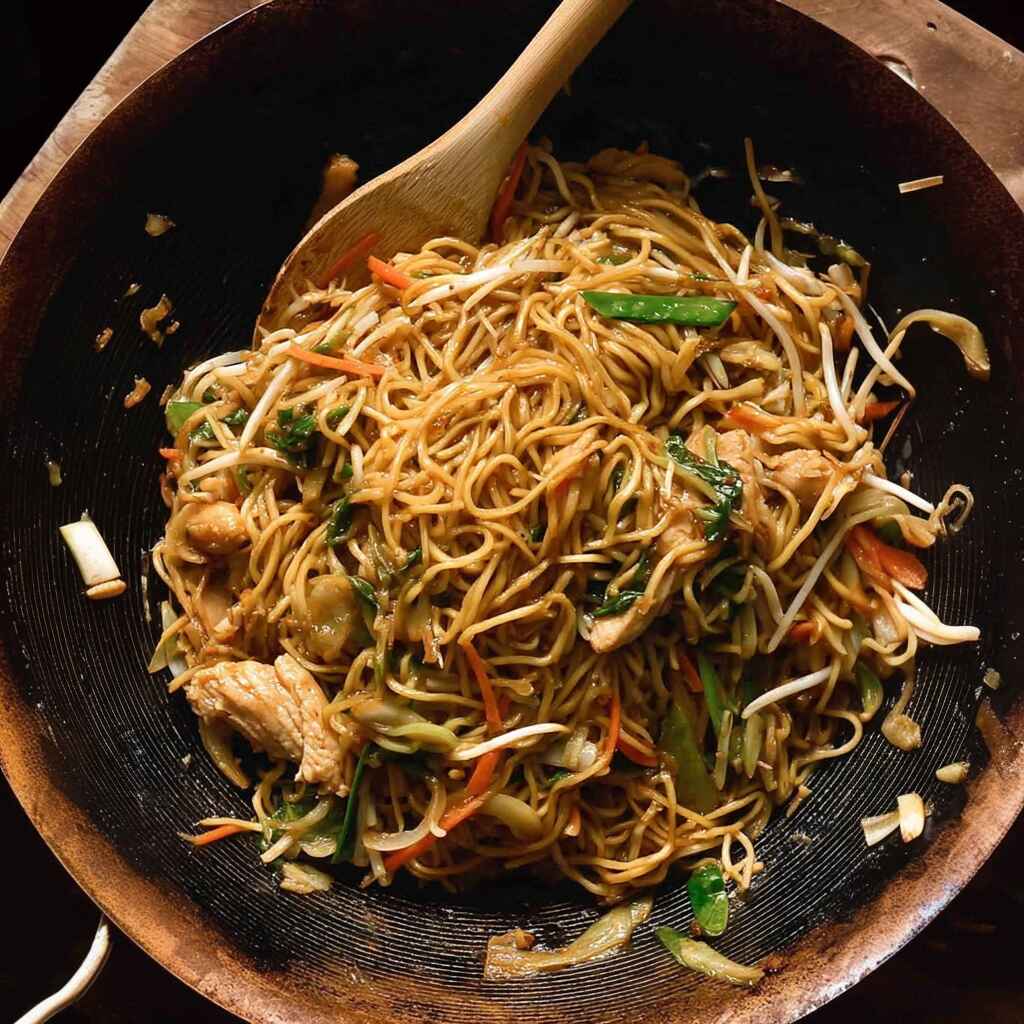There’s something oddly comforting about twirling slippery noodles around your fork, knowing you’re minutes away from savory bliss. But let’s be honest trying to recreate that takeout magic at home often leaves us with soggy noodles, bland sauce, or worse, a chaotic kitchen. I’ve been there. That’s exactly why I kept returning to this Chicken Chow Mein recipe until it was foolproof. This version delivers bold flavor, a glossy, sticky-salty sauce, and perfectly cooked noodles. Better yet? It’s faster than your favorite delivery app and a whole lot more satisfying.
Why This Chicken Chow Mein Works Every Time
There are stir-fry nights when everything feels rushed kids whining, the pan smoking, sauce splattering but this Chicken Chow Mein never lets me down. The secret? It’s not just about the ingredients, but how they come together. Each element is simple, but the synergy is where the magic lives.
The sauce is what ties everything together. It’s silky, salty, and just sweet enough to balance the umami-rich oyster sauce and toasty sesame oil. A touch of cornstarch gives it that classic restaurant-style gloss without making it gluey. I tested dozens of combinations before landing on this exact ratio. It’s bold enough to flavor every strand of noodle, yet light enough that you don’t feel weighed down after eating.
What makes it truly weeknight-worthy is its rhythm. You start with a flash of garlic in hot oil, layer in the chicken until it browns just slightly, then toss in veggies that hold their crunch. It all happens quickly like a dance. The noodles go in last, soaking up the sauce and binding everything in glossy harmony.
And then there’s the versatility. You can swap out the chicken for shrimp or tofu, throw in bell peppers or snap peas, even use crispy baked chicken thighs for a smoky twist. The result? A dish that feels like takeout but tastes even better because you made it.
You can even repurpose leftover sauce and use it to flavor other quick meals, like these hearty chicken burrito bowls an easy way to stretch flavor across your week.Once you get the hang of it, you’ll start dreaming up your own veggie combos or protein swaps. That’s the beauty of a dish that’s both reliable and deeply flexible. And if you mess up? Just toss in a splash more sauce she’s forgiving like that.
Ingredients, Swaps & Foolproof Steps for Chicken Chow Mein
This Chicken Chow Mein recipe doesn’t call for exotic ingredients or specialty tools. It’s pantry-friendly, quick to prep, and surprisingly adaptable. Whether you’re feeding picky kids or craving something soul-satisfying for yourself, this is your no-fuss, high-reward meal.
Key Ingredients (and Smart Swaps)
- Chicken thigh – Juicier and more forgiving than breast. But if you prefer lean cuts, tenderize breast using baking soda (Chinese “velveting”).
- Chow Mein noodles – These thin, curly egg noodles are ideal, but if you’re in a pinch, try ramen noodles (toss the seasoning packet!) or spaghetti.
- Cabbage & carrot – Shredded into noodle-like strips, they practically disappear, which makes this dish sneakily veggie-packed.
- Bean sprouts – Added at the end for crunch and freshness.
- Chow Mein sauce – Soy sauce, oyster sauce, sesame oil, cornstarch, a pinch of sugar, and a splash of Chinese cooking wine or broth.
Looking for more cozy one-pan dinners? You’ll love this garlic parmesan chicken and pasta recipe it’s another weeknight wonder that doesn’t skimp on flavor.
Common Mistakes to Avoid
- Overcooking the noodles – They should be soft but still springy, not mushy.
- Skipping the marinade – Even 10 minutes makes your chicken juicy and flavorful.
- Crowding the pan – Use a big skillet so everything sautés, not steams.
Pro Tips
- Use high heat and don’t walk away the whole dish comes together in about 5 minutes.
- Keep the sauce pre-mixed and ready before you start cooking.
- Stir-fry the vegetables briefly to preserve their color and crunch.
Ingredient & Substitution Table
| Ingredient | Halal-Friendly Substitute | Notes |
|---|---|---|
| Chinese cooking wine | Chicken broth or apple juice | Adds flavor without alcohol |
| Oyster sauce | Hoisin or mushroom stir-fry sauce | For a vegetarian-friendly twist |
| Chow Mein noodles | Ramen (no packet), spaghetti | Look for egg noodles for best texture |
| Chicken thigh | Tofu, shrimp, ground turkey | Always marinate for flavor |
Nutrition Highlights
| Nutrient | Per Serving |
|---|---|
| Protein | 28g |
| Carbs | 46.5g |
| Fat | 31.2g |
Step-by-Step Instructions
- Make the Sauce: In a small bowl, whisk soy sauce, oyster sauce, sesame oil, sugar, cooking wine (or broth), and cornstarch.
- Marinate the Chicken: Toss thinly sliced chicken with a tablespoon of sauce. Let sit for 10 minutes.
- Prepare the Noodles: Soak or boil noodles according to package directions, then drain well.
- Heat the Oil: In a large wok or skillet over high heat, sauté chopped garlic for 10 seconds.
- Cook the Chicken: Add chicken and stir-fry until slightly browned but not fully cooked through about 1 minute.
- Add Vegetables: Stir in cabbage, carrots, and the white part of green onions. Stir-fry 1½ minutes.
- Add Noodles & Sauce: Toss in noodles, the remaining sauce, and a splash of water. Stir-fry until glossy and coated.
- Finish with Bean Sprouts: Toss in bean sprouts and green onion tops. Cook 30 seconds, then remove from heat.
For a heartier take, try serving alongside this chicken francese for a full Chinese-Italian fusion night. Who says you have to choose?
Serving, Storage & Freezer Tips for Chicken Chow Mein
This Chicken Chow Mein isn’t just for the weeknight rush it’s also perfect for next-day lunches, potlucks, or freezing for those “what’s for dinner?” moments. With the right storage and reheating methods, it tastes just as good the next day (if not better).
How to Serve Chicken Chow Mein
Serve this dish piping hot, straight from the wok or skillet. For presentation, try a shallow bowl with a sprinkle of green onion and toasted sesame seeds. Want to elevate it further? Pair it with a cool, crisp side like this classic chicken salad for balance, or toss together a quick cucumber sesame slaw.
Some fun ways to customize:
- Add crushed peanuts or cashews for crunch.
- Stir in chili garlic sauce for a spicy kick.
- Serve over a bed of shredded romaine for a noodle salad twist.
How to Store
Leftovers store beautifully. Let the noodles cool to room temperature, then transfer them into an airtight container.
- Fridge: Keeps for up to 4 days
- Reheating: Microwave in 30-second bursts, stirring between each, or heat in a skillet with a splash of water to revive the sauce.
Tip: Keep the bean sprouts separate if you plan to store, and toss them in fresh before reheating for best texture.
Can You Freeze Chicken Chow Mein?
Yes, but with care. The noodles can become slightly softer upon reheating, but the flavor holds up beautifully.
- Freeze in single-portion airtight containers for up to 1 month.
- Thaw overnight in the fridge.
- Reheat in a nonstick pan over medium heat with 1–2 tablespoons of water or broth to prevent dryness.
Want another freezer-friendly favorite? This chicken and rice soup is a cozy backup plan for rainy nights and sick days.
A Personal Note from Jacqueline
Whenever I pack this up for my kids’ lunches or freeze a portion for a future lazy day, I feel like I’m passing along a little kitchen love. It’s a recipe that forgives, flexes, and nourishes. The noodles might be slippery, but the comfort sticks with you.
Chicken Chow Mein FAQ
1. Can I use spaghetti instead of Chow Mein noodles?
Yes, absolutely! While authentic Chow Mein uses thin, crinkly egg noodles, regular spaghetti is a great substitute if you’re in a pinch. Just cook it slightly al dente and rinse it under cold water to stop the cooking this gives you a firm texture that works well for stir-fries. You’ll still get a delicious, satisfying result.
2. What vegetables go best with Chicken Chow Mein?
Classic Chow Mein always includes shredded cabbage, carrots, and bean sprouts, but the sky’s the limit. Try adding bell peppers, snow peas, mushrooms, or baby spinach. The key is slicing everything into “noodle-like” strips so it blends seamlessly. Bonus: it’s a sneaky way to boost veggie intake without complaints.
3. Can I make it gluten-free?
Definitely. Swap the soy sauce for gluten-free tamari and use a gluten-free oyster sauce alternative (there are several on the market). Make sure your noodles are certified gluten-free some rice noodles or gluten-free spaghetti work great here. You’ll still get that rich, sticky-salty flavor without compromising your needs.
4. How do I store leftovers?
Let your Chicken Chow Mein cool completely before transferring to an airtight container. It keeps beautifully in the fridge for up to 4 days. When reheating, add a splash of water or broth to help loosen the sauce and revive the noodles. For freezing, store in portioned containers and thaw overnight in the fridge before reheating.
Conclusion
Chicken Chow Mein is more than just a quick weeknight dinner it’s a memory-maker. Whether you’re reliving takeout nights from your college days or introducing your kids to their first slurp-worthy noodles, this recipe has the power to bring people together around the table.
Chicken Chow Mein might just be the recipe you didn’t know you needed, until it saved your Tuesday night.
If this recipe reminds you of someone you love, share it with them. Your memories keep recipes alive.
YOU MAY ALSO LIKE
Chicken Chow Mein
Ingredients
Equipment
Method
- Whisk together the soy sauce, oyster sauce, sesame oil, sugar, chicken broth, and cornstarch in a small bowl. Set aside.
- Marinate sliced chicken in 1 tablespoon of the sauce. Let sit for 10 minutes.
- Cook noodles according to package instructions. Drain and set aside.
- Heat oil in a large wok over high heat. Add garlic and sauté 10 seconds.
- Add chicken and stir-fry until browned but still slightly pink inside.
- Add cabbage, carrots, and white parts of green onions. Stir-fry for 1½ minutes.
- Add noodles, remaining sauce, and water. Stir-fry for 1 minute until noodles are coated.
- Add bean sprouts and green onion tops. Toss and cook for 30 seconds. Serve hot.

